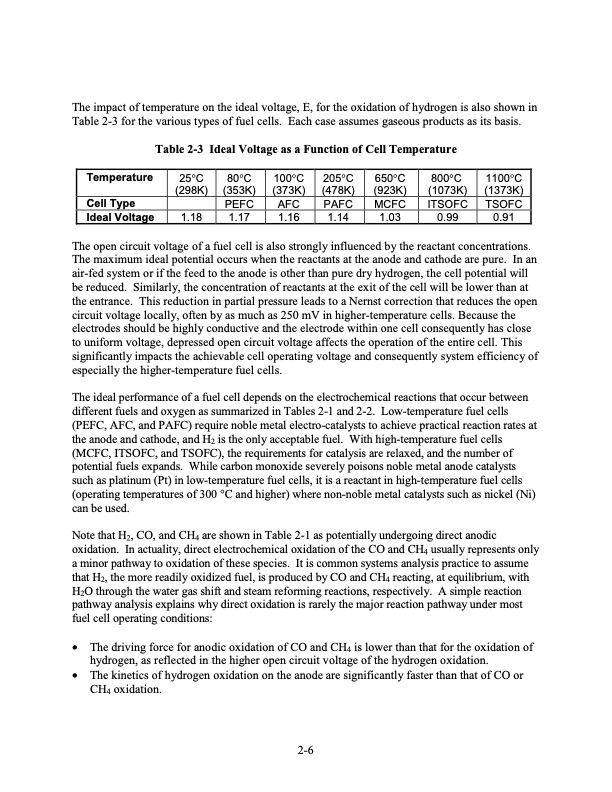
PDF Publication Title:
Text from PDF Page: 059
The impact of temperature on the ideal voltage, E, for the oxidation of hydrogen is also shown in Table 2-3 for the various types of fuel cells. Each case assumes gaseous products as its basis. Temperature Cell Type Ideal Voltage Table 2-3 Ideal Voltage as a Function of Cell Temperature 25°C 80°C 100°C 205°C 650°C 800°C (298K) (353K) (373K) (478K) (923K) (1073K) PEFC AFC PAFC MCFC ITSOFC 1.18 1.17 1.16 1.14 1.03 0.99 1100°C (1373K) TSOFC 0.91 The open circuit voltage of a fuel cell is also strongly influenced by the reactant concentrations. The maximum ideal potential occurs when the reactants at the anode and cathode are pure. In an air-fed system or if the feed to the anode is other than pure dry hydrogen, the cell potential will be reduced. Similarly, the concentration of reactants at the exit of the cell will be lower than at the entrance. This reduction in partial pressure leads to a Nernst correction that reduces the open circuit voltage locally, often by as much as 250 mV in higher-temperature cells. Because the electrodes should be highly conductive and the electrode within one cell consequently has close to uniform voltage, depressed open circuit voltage affects the operation of the entire cell. This significantly impacts the achievable cell operating voltage and consequently system efficiency of especially the higher-temperature fuel cells. The ideal performance of a fuel cell depends on the electrochemical reactions that occur between different fuels and oxygen as summarized in Tables 2-1 and 2-2. Low-temperature fuel cells (PEFC, AFC, and PAFC) require noble metal electro-catalysts to achieve practical reaction rates at the anode and cathode, and H2 is the only acceptable fuel. With high-temperature fuel cells (MCFC, ITSOFC, and TSOFC), the requirements for catalysis are relaxed, and the number of potential fuels expands. While carbon monoxide severely poisons noble metal anode catalysts such as platinum (Pt) in low-temperature fuel cells, it is a reactant in high-temperature fuel cells (operating temperatures of 300 °C and higher) where non-noble metal catalysts such as nickel (Ni) can be used. Note that H2, CO, and CH4 are shown in Table 2-1 as potentially undergoing direct anodic oxidation. In actuality, direct electrochemical oxidation of the CO and CH4 usually represents only a minor pathway to oxidation of these species. It is common systems analysis practice to assume that H2, the more readily oxidized fuel, is produced by CO and CH4 reacting, at equilibrium, with H2O through the water gas shift and steam reforming reactions, respectively. A simple reaction pathway analysis explains why direct oxidation is rarely the major reaction pathway under most fuel cell operating conditions: • The driving force for anodic oxidation of CO and CH4 is lower than that for the oxidation of hydrogen, as reflected in the higher open circuit voltage of the hydrogen oxidation. • The kinetics of hydrogen oxidation on the anode are significantly faster than that of CO or CH4 oxidation. 2-6PDF Image | Fuel Cell Handbook (Seventh Edition)

PDF Search Title:
Fuel Cell Handbook (Seventh Edition)Original File Name Searched:
fuel-cell-handbook.pdfDIY PDF Search: Google It | Yahoo | Bing
NFT (Non Fungible Token): Buy our tech, design, development or system NFT and become part of our tech NFT network... More Info
IT XR Project Redstone NFT Available for Sale: NFT for high tech turbine design with one part 3D printed counter-rotating energy turbine. Be part of the future with this NFT. Can be bought and sold but only one design NFT exists. Royalties go to the developer (Infinity) to keep enhancing design and applications... More Info
Infinity Turbine IT XR Project Redstone Design: NFT for sale... NFT for high tech turbine design with one part 3D printed counter-rotating energy turbine. Includes all rights to this turbine design, including license for Fluid Handling Block I and II for the turbine assembly and housing. The NFT includes the blueprints (cad/cam), revenue streams, and all future development of the IT XR Project Redstone... More Info
Infinity Turbine ROT Radial Outflow Turbine 24 Design and Worldwide Rights: NFT for sale... NFT for the ROT 24 energy turbine. Be part of the future with this NFT. This design can be bought and sold but only one design NFT exists. You may manufacture the unit, or get the revenues from its sale from Infinity Turbine. Royalties go to the developer (Infinity) to keep enhancing design and applications... More Info
Infinity Supercritical CO2 10 Liter Extractor Design and Worldwide Rights: The Infinity Supercritical 10L CO2 extractor is for botanical oil extraction, which is rich in terpenes and can produce shelf ready full spectrum oil. With over 5 years of development, this industry leader mature extractor machine has been sold since 2015 and is part of many profitable businesses. The process can also be used for electrowinning, e-waste recycling, and lithium battery recycling, gold mining electronic wastes, precious metals. CO2 can also be used in a reverse fuel cell with nafion to make a gas-to-liquids fuel, such as methanol, ethanol and butanol or ethylene. Supercritical CO2 has also been used for treating nafion to make it more effective catalyst. This NFT is for the purchase of worldwide rights which includes the design. More Info
NFT (Non Fungible Token): Buy our tech, design, development or system NFT and become part of our tech NFT network... More Info
Infinity Turbine Products: Special for this month, any plans are $10,000 for complete Cad/Cam blueprints. License is for one build. Try before you buy a production license. May pay by Bitcoin or other Crypto. Products Page... More Info
| CONTACT TEL: 608-238-6001 Email: greg@infinityturbine.com | RSS | AMP |